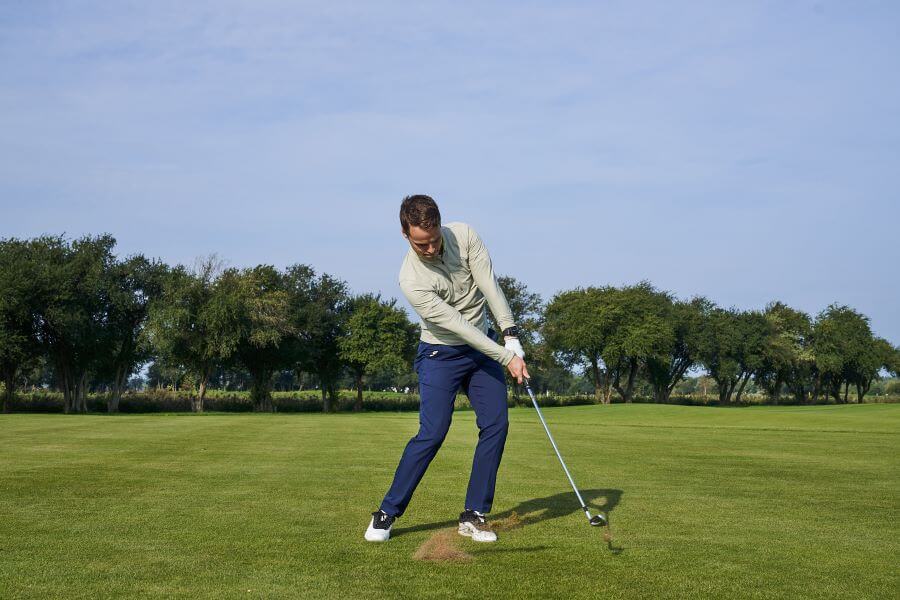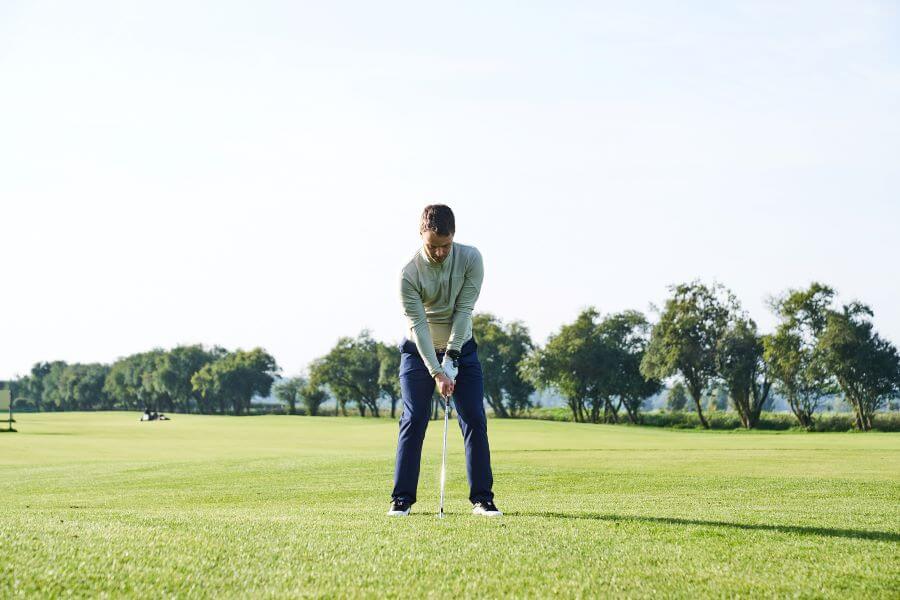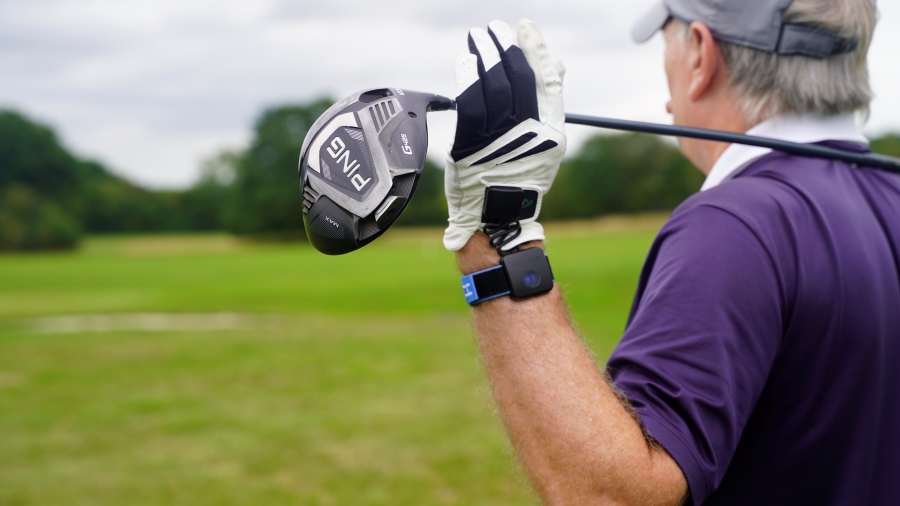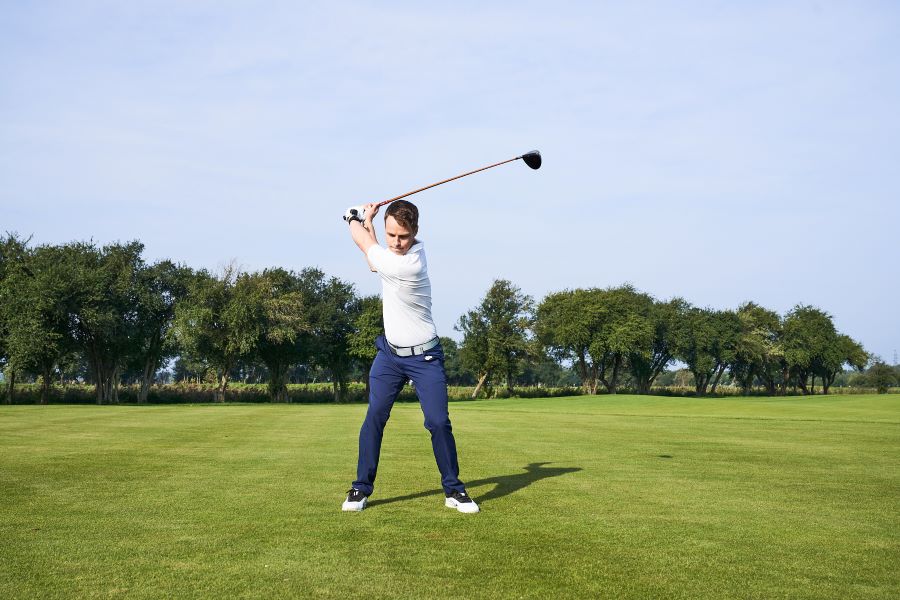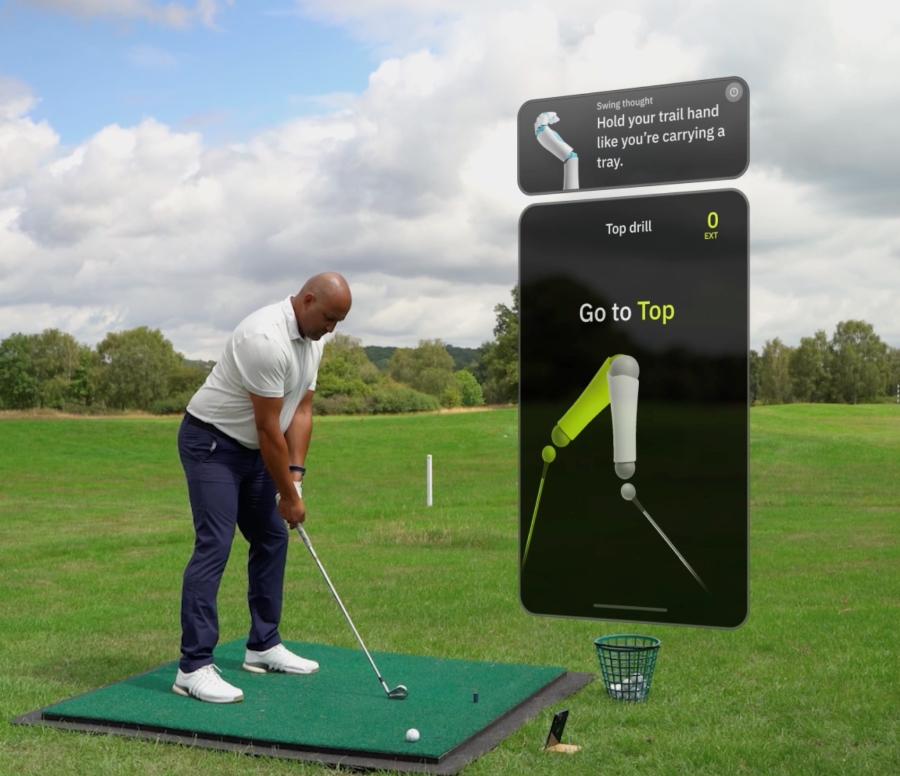Body Rotation in the Golf Swing (Why Can’t You Rotate the Way You Want?)
A golfer who can rotate their body well through the swing often hits more solid shots, generates more distance, and keeps the ball flight on a predictable line.
But for many amateurs, rotation is hard. It’s not just because they’re “just not flexible enough,” but because their wrists and clubface are in a position that makes rotation nearly impossible.
If your clubface is open in the downswing, your body will often stall so your hands can flip the face square. If your wrists are in a stronger, more flexed position, rotation becomes natural. Some even call it easy at this point.
In this guide, we’ll break down why body rotation matters, how to set yourself up for it, and three proven drills you can take to the range today.
Body Rotation in Golf (Key Takeaways)
Here are some of the most important things to know about body rotation in the golf swing. Save these points:
- Rotation is only as good as your clubface position. A stronger (more closed) clubface in the downswing encourages more rotation.
- Open clubface = stalled body. If the face is open, your body will slow down so your hands can catch up, leading to inconsistent contact.
- Better wrist angles improve rotation. Using HackMotion, you can train the lead wrist into slight flexion at the top and early downswing.
- Weight forward at impact is essential. All great ball strikers have more weight on their lead foot at impact than at address.
- Start small, then build speed. Begin drills slowly to ingrain movement patterns, then work toward full swings.
Prefer watching over reading? Watch the video below to learn how to master body rotation in your golf swing.
Contents
Why Body Rotation Matters
Body rotation in golf is how your torso, hips, and shoulders pivot during the swing. While you rotate in the backswing, the most important rotation happens through the ball in the downswing and into impact.
Rotation allows you to:
- Maintain a square clubface without flipping the hands.
- Create forward shaft lean for better compression.
- Generate speed with your entire body, not just your arms.
When the clubface is in the correct position in the downswing, meaning the lead wrist has moved toward flexion and the face is slightly down-looking, your body has the green light to rotate through.
This is what you see with players like Dustin Johnson, Collin Morikawa, and Jon Rahm.
If the face is open (lead wrist extended, toe pointing skyward), rotation becomes a liability.
Your body has to slow or stop so your hands can catch up, leading to higher loft, weaker shots, and a mix of fat and thin contact.
Proper Body Rotation and How to Get It
We all know that body rotation is important, so now the key of how to work on it comes into play.
These are the steps to take to make it easier to rotate your body in golf.
1. Start with Weight Forward
A forward weight bias at address sets up a more stable pivot and makes it easier to control the bottom of your swing. With your weight forward, you don’t have to make a big lateral shift during the downswing.
Start with about 60% of your weight on your lead foot (left for right-handers) and feel it remain there as you complete your backswing.
Then, in the downswing, allow the hips to slide slightly toward the target, increasing the forward pressure on that front leg.
Every great ball striker arrives at impact with more weight forward than they had at address. Forward weight moves the low point of your swing in front of the ball, letting you hit the ball first, turf second. It’s one of the most reliable ways to improve ball striking almost instantly.
2. Control the Clubface Early
Your ability to rotate through impact is directly tied to how square your clubface is before you reach the ball. If the face is open, your subconscious will slow or stall rotation so you have time to square it, which kills speed and consistency.
Train your lead wrist to be slightly flexed (bowed) in transition. This strengthens the clubface, points it slightly more toward the ground, and eliminates the need for last-second manipulations.
With the face in this position, your body is “free” to keep turning aggressively through impact.
HackMotion can help you measure this. Use it to check your lead wrist at the top of the swing and in the first move down. Players like Dustin Johnson, Collin Morikawa, and Jon Rahm rotate so well because they don’t have to “save” the face. The position is already there when they transition to the downswing.
3. Match Your Rotation to Your Face
The amount of body rotation you can use depends on your clubface position in the downswing:
- Closed/strong face: You can rotate more aggressively without fear of missing right.
- Neutral face: You can still rotate well, but you may need to match your release pattern carefully.
- Open face: Rotation must slow so the hands can catch up, which is why fixing the face should come first.
Understanding this match-up keeps your swing from feeling like a fight between your hands and your body. When the clubface and rotation are in sync, contact improves and dispersion tightens.
Take some slow-motion swings where you exaggerate this concept and feel that rotation.
4. Blend Hands, Arms, and Body
Rotation isn’t just about the lower body, it’s about sequencing. In the downswing, the body starts turning, the arms drop into position, and the wrists maintain their angle. All three pieces must blend together.
If the arms race ahead of the body, you’ll flip and lose rotation. If the body outpaces the arms, you might block shots or leave the face open. Use slow-motion practice to feel the arms and body moving as one unit into impact.
The days when you play your best golf will likely be when you have everything working together.
Three Drills for Better Body Rotation
If the concept of proper body rotation still feels kind of abstract try one of these three drills to help improve.
Alignment Stick Rotation Drill
This drill forces you to turn your body through impact instead of flipping your wrists.
The extended stick gives immediate feedback if you stall your rotation. The stick hits your side and reminds you that you need to rotate.
Purpose: Connect arms and body, promote forward shaft lean, and train consistent rotation through the ball.
Alignment Stick Rotation Drill – Step by Step
- Slide an alignment stick down the back of your club grip so it extends several inches past the handle.
- At setup, the stick should point just left of your lead hip (for right-handers).
- Make half swings, keeping the stick away from your body in the downswing.
- If the stick hits your side, you’ve stalled your body or flipped your wrists.
- Start slow without a ball, then progress to small punch shots with a slight draw.
Smart Ball Connection Drill
Keeping a ball between your forearms helps your arms and body work together. It also prevents your elbows from separating, a common cause of poor contact and loss of rotation.
Purpose: Improve sequencing, keep arms connected to the body, and maintain structure in the swing.
Smart Ball Connection Drill – Step by Step
- Place an inflated Smart Ball (or similar) between your forearms.
- Hit half swings while keeping the ball in place if it drops, your arms have separated or wrists have broken down.
- Focus on turning your body through the shot while squeezing the ball gently.
- Progress to fuller swings with wedges, then longer clubs.
HackMotion Casting Drill
Casting (early wrist release) destroys rotation by forcing you to flip at the ball. This drill uses HackMotion feedback to train the correct wrist angles in transition, giving you a stronger face and more freedom to rotate.
Purpose: Eliminate casting, improve wrist angles in transition, and support aggressive body rotation.
Fix Your Casting with HackMotion
Train to fix casting by generating power with your core and lower body.
HackMotion Casting Drill – Step by Step
- Wear your HackMotion sensor and set up the Casting Drill in the app.
- Swing to the top and, in transition, maintain or slightly decrease the angle between your lead arm and the shaft.
- Green feedback means you’ve avoided casting; red means you’ve released early.
- Start with slow practice swings, then add balls, maintaining both wrist angle and forward weight shift.
- Track your data to confirm consistent wrist patterns.
FAQs
Here are a few of the most commonly asked questions about the body rotation in the golf swing.
How do you rotate your body in the downswing?
At the top of the backswing, your body will rotate towards the target. The more square your clubface is at the top, the easier it is for your body to rotate without stopping, slowing down, or compensating for the angle of your clubface.
How can I increase my body rotation?
To increase your body rotation, ensure that you are starting with enough rotation on the takeaway of your golf swing. If you are not starting with a turn, it’s hard to add one on the downswing.
In addition, golfers who become more flexible often have an easier time rotating their bodies. Lastly, ensure your swing plane is more shallow, and the club is square so that you are able to rotate quickly through the ball.
How far do you rotate your hips in golf swing?
Start by feeling like you are turning your belt buckle away from the ball at the start of your swing. As you pivot back and transfer weight, the rotation will continue.
The rotation will turn in the opposite direction during the transition from backswing to downswing.
Can you turn too much in golf swing?
In a golf swing, you can turn too much if you make it difficult for yourself to return the golf club to square. For many players over-rotation means that there are compensations that you must make to get back to impact.
Rotation doesn’t need to be large to be effective. However, it must be consistent, and it must correspond with a shaft that is on the plane and a clubface that is square.
Final Thoughts
Most golfers think of rotation as a “body move,” but it’s the by-product of having the clubface and wrists in a position that allows it. Get those right, and rotation becomes a natural reaction, not something you force.
Set up with weight forward, strengthen your wrist position in transition, and use drills that keep your arms and body working together. HackMotion’s feedback shortens the learning curve and ensures you’re building the right patterns.






